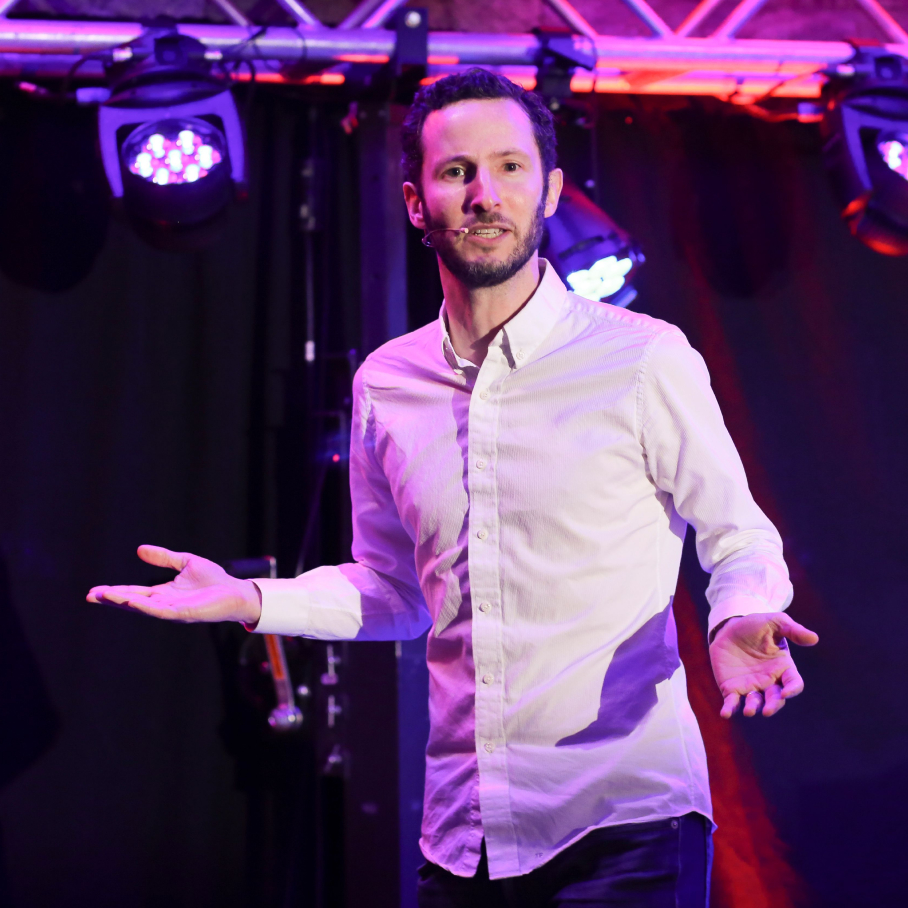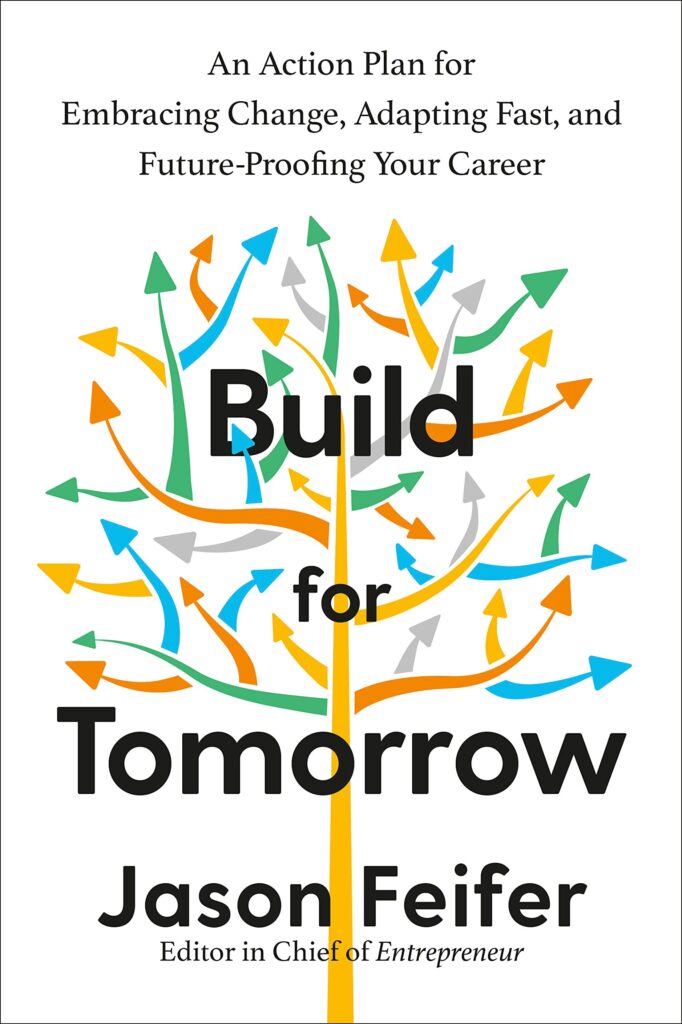
If there’s one thing we’ve all been dealing with the last few years, it’s the chaos of change. And all that change can really disrupt your life.
But if you ask Jason Feifer, change can be good. A self-described “nonstop optimism machine,” Jason is the editor in chief of Entrepreneur magazine, a podcast host, keynote speaker, startup advisor – and the author of the brand-new book Build for Tomorrow: An Action Plan for Embracing Change, Adapting Fast, and Future-Proofing Your Career.
If you’re wondering how to navigate the world of constant change we’re all living in, his book aims to help you become more resilient and adaptable. I chatted with Jason about his inspiring journey.

Q: Jason, tell us briefly about the road to becoming editor in chief of Entrepreneur magazine, and how you believe ‘Opportunity Set B’ helped make it happen.
“‘Opportunity Set B’ got me here! To explain – I believe that everyone has two sets of opportunities. The first, which I call ‘Opportunity Set A,’ is everything that’s asked of you at your job. The second, which I call ‘Opportunity Set B,’ is everything that’s available to you but that nobody is asking you to do. Maybe it’s joining a new team at work, or maybe it’s developing a new skill outside of work. Now here’s the thing: ‘Opportunity Set B’ is always more important, because that’s where growth happens! If you only focus on ‘Opportunity Set A,’ you’ll only be qualified to do the thing you’re already doing.
“So that’s how I’ve approached my career. I have never just held one job; I have always been freelancing and developing new skills on the side. That allowed me to start as a small-town newspaper reporter, skip a lot of steps over the years and end up running a national magazine.”
Q: Entrepreneurs face challenges, obstacles and chaos – I call that fire. Can you describe an unexpected fire you fought along your journey and how you overcame it?
“Sure. I was fired from one of my magazine jobs. My boss decided I wasn’t contributing enough, and frankly, he was right. That job wasn’t a good fit for me, and yet I’d held onto it because I didn’t know what to do next. Getting fired forced me to make some tough decisions, rethink what I wanted, and then focus on getting it. That was the best thing to ever happen to me.”
Q: You talk a lot about using change to your advantage. What does that mean?
“I’ve spent years understanding how the most successful people navigate change, and have come to discover that everyone experiences change in four phases: Panic, Adaptation, New Normal, and Wouldn’t Go Back. That last part is the most important: It’s when we have something so new and valuable that we say, ‘I wouldn’t want to go back to a time before I had it.’
“This is available to all of us; change drives new needs, new opportunities and new directions. It upends existing power structures and makes way for new ones. But in order to take advantage of this, we must treat it like an opportunity – and not like something to avoid!”
Q: You stress the importance of resilience. In fact, you wrote the book on adapting and reinventing yourself, Build for Tomorrow. Tell us why you wrote the book.
“Ever since I became editor in chief of Entrepreneur, people asked me this one question: ‘What are the qualities of successful people?’ I didn’t know the answer at first, so I spent years talking to people about it and studying the patterns of success. Then I had my answer: Adaptability is the greatest key to success! And this isn’t something people are born with. It’s a skill you can learn.

“When the pandemic began, we all experienced a massive change that would reverberate for years, if not for the rest of our lives. I knew I wanted to share what I’d learned to help people find the next opportunity.”
Q: Build for Tomorrow sounds like important reading for anyone who wants to thrive during turbulent times like these. What do you hope readers take away from your book?
“That they’re in control. Change does not just ‘happen’ to you. It is a door you can walk through. There is so much you can do to prepare for it, and then to take advantage of it. Now is an amazing time of potential growth!”
Q: You interviewed a lot of entrepreneurs, celebrities and business leaders for your book. Any key takeaways from these changemakers to share?
“There are so many. But here’s one that always sticks with me: Ryan Reynolds told me, ‘In order to be good at something, you have to be willing to be bad.’ It’s so true! Because here’s the thing – when we try something new, we are often discouraged by our lack of expertise. We may walk into a role, or try a new task, and become frustrated that we aren’t as good as we’d like to be. But that’s totally normal. The question isn’t whether we’re fast experts; the question is whether we can persevere through the discomfort. Most people can’t. Which is why you should.”
Q: It’s easy to be discouraged when it feels like life throws you a curveball or your cheese gets moved. What are your top three tips for those who want to build for tomorrow and future-proof their careers?
“First, do what I call ‘work your next job.’ Embrace the ‘Opportunity Set B’ that I spoke about earlier, and start developing the skills you’ll use next, even if you don’t know how they’ll be useful later.
“Second, stop thinking of yourself as someone who simply does a certain job, and push yourself to identify the core value you bring to the world. That will help you feel grounded when your job or tasks change.
“And third, remember this: You can ‘reconsider the impossible.’ Take a close look at the ideas or options you once dismissed as too crazy or difficult. You might just find that they’re the greatest opportunities you’ve ever had, just lying there waiting for you.”
Q: Awesome advice! How can readers stay in touch with you and follow your journey?
“First of all, I’d love for people to pick up the book! Then tell me what you think. I promise, I reply to everyone who reaches out. You can reach me on Instagram or LinkedIn or Twitter.”

Photos courtesy of JasonFeifer.com.
Want more insights on resilience and success? You can order a copy of Become the Fire (foreword by Mary Dillon, CEO of Foot Locker, former CEO of Ulta Beauty) for yourself or for someone you think may benefit from the stories and lessons shared by myself and a diverse group of highly successful leaders. Learn more about the book.
Subscribe!

If there’s one thing we’ve all been dealing with the last few years, it’s the chaos of change. And all that change can really disrupt your life.
But if you ask Jason Feifer, change can be good. A self-described “nonstop optimism machine,” Jason is the editor in chief of Entrepreneur magazine, a podcast host, keynote speaker, startup advisor – and the author of the brand-new book Build for Tomorrow: An Action Plan for Embracing Change, Adapting Fast, and Future-Proofing Your Career.
If you’re wondering how to navigate the world of constant change we’re all living in, his book aims to help you become more resilient and adaptable. I chatted with Jason about his inspiring journey.

Q: Jason, tell us briefly about the road to becoming editor in chief of Entrepreneur magazine, and how you believe ‘Opportunity Set B’ helped make it happen.
“‘Opportunity Set B’ got me here! To explain – I believe that everyone has two sets of opportunities. The first, which I call ‘Opportunity Set A,’ is everything that’s asked of you at your job. The second, which I call ‘Opportunity Set B,’ is everything that’s available to you but that nobody is asking you to do. Maybe it’s joining a new team at work, or maybe it’s developing a new skill outside of work. Now here’s the thing: ‘Opportunity Set B’ is always more important, because that’s where growth happens! If you only focus on ‘Opportunity Set A,’ you’ll only be qualified to do the thing you’re already doing.
“So that’s how I’ve approached my career. I have never just held one job; I have always been freelancing and developing new skills on the side. That allowed me to start as a small-town newspaper reporter, skip a lot of steps over the years and end up running a national magazine.”
Q: Entrepreneurs face challenges, obstacles and chaos – I call that fire. Can you describe an unexpected fire you fought along your journey and how you overcame it?
“Sure. I was fired from one of my magazine jobs. My boss decided I wasn’t contributing enough, and frankly, he was right. That job wasn’t a good fit for me, and yet I’d held onto it because I didn’t know what to do next. Getting fired forced me to make some tough decisions, rethink what I wanted, and then focus on getting it. That was the best thing to ever happen to me.”
Q: You talk a lot about using change to your advantage. What does that mean?
“I’ve spent years understanding how the most successful people navigate change, and have come to discover that everyone experiences change in four phases: Panic, Adaptation, New Normal, and Wouldn’t Go Back. That last part is the most important: It’s when we have something so new and valuable that we say, ‘I wouldn’t want to go back to a time before I had it.’
“This is available to all of us; change drives new needs, new opportunities and new directions. It upends existing power structures and makes way for new ones. But in order to take advantage of this, we must treat it like an opportunity – and not like something to avoid!”
Q: You stress the importance of resilience. In fact, you wrote the book on adapting and reinventing yourself, Build for Tomorrow. Tell us why you wrote the book.
“Ever since I became editor in chief of Entrepreneur, people asked me this one question: ‘What are the qualities of successful people?’ I didn’t know the answer at first, so I spent years talking to people about it and studying the patterns of success. Then I had my answer: Adaptability is the greatest key to success! And this isn’t something people are born with. It’s a skill you can learn.

“When the pandemic began, we all experienced a massive change that would reverberate for years, if not for the rest of our lives. I knew I wanted to share what I’d learned to help people find the next opportunity.”
Q: Build for Tomorrow sounds like important reading for anyone who wants to thrive during turbulent times like these. What do you hope readers take away from your book?
“That they’re in control. Change does not just ‘happen’ to you. It is a door you can walk through. There is so much you can do to prepare for it, and then to take advantage of it. Now is an amazing time of potential growth!”
Q: You interviewed a lot of entrepreneurs, celebrities and business leaders for your book. Any key takeaways from these changemakers to share?
“There are so many. But here’s one that always sticks with me: Ryan Reynolds told me, ‘In order to be good at something, you have to be willing to be bad.’ It’s so true! Because here’s the thing – when we try something new, we are often discouraged by our lack of expertise. We may walk into a role, or try a new task, and become frustrated that we aren’t as good as we’d like to be. But that’s totally normal. The question isn’t whether we’re fast experts; the question is whether we can persevere through the discomfort. Most people can’t. Which is why you should.”
Q: It’s easy to be discouraged when it feels like life throws you a curveball or your cheese gets moved. What are your top three tips for those who want to build for tomorrow and future-proof their careers?
“First, do what I call ‘work your next job.’ Embrace the ‘Opportunity Set B’ that I spoke about earlier, and start developing the skills you’ll use next, even if you don’t know how they’ll be useful later.
“Second, stop thinking of yourself as someone who simply does a certain job, and push yourself to identify the core value you bring to the world. That will help you feel grounded when your job or tasks change.
“And third, remember this: You can ‘reconsider the impossible.’ Take a close look at the ideas or options you once dismissed as too crazy or difficult. You might just find that they’re the greatest opportunities you’ve ever had, just lying there waiting for you.”
Q: Awesome advice! How can readers stay in touch with you and follow your journey?
“First of all, I’d love for people to pick up the book! Then tell me what you think. I promise, I reply to everyone who reaches out. You can reach me on Instagram or LinkedIn or Twitter.”

Photos courtesy of JasonFeifer.com.
Want more insights on resilience and success? You can order a copy of Become the Fire (foreword by Mary Dillon, CEO of Foot Locker, former CEO of Ulta Beauty) for yourself or for someone you think may benefit from the stories and lessons shared by myself and a diverse group of highly successful leaders. Learn more about the book.